Samsung QE55S95B Review
Samsung's S95B takes OLED to new levels of brightness
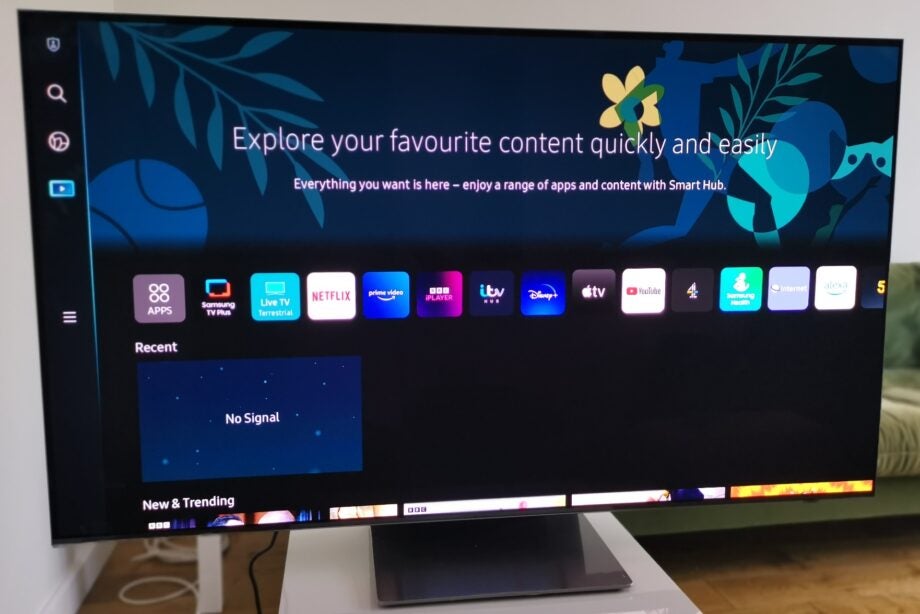

Verdict
The Samsung S95B is an excellent 4K flatscreen, and an impressive debut for QD-OLED technology. It effectively combines the brightness of high-end QLED with the black level performance expected from OLED. It even manages to sound decent, despite its slimline design.
Obviously, the lack of Dolby Vision will be a deal breaker for many home cinema fans, but a competitive price tag is ample compensation. If you’re simply looking for a colour rich OLED that doesn’t struggle in bright room viewing environments, this 55-inch QD-OLED is near irresistible..
Pros
- Dynamic HDR performer
- Neural Quantum Processor 4K
- Ultra slim design
- 4K 120Hz HDMI support
Cons
- No Dolby Vision
- Unsubtle gaming performance
Key Features
- QD-OLED panelNew panel for higher brightness HDR
- TizenRefreshed smart interface with Game Hub
- AudioObject Tracking Sound system and Dolby Atmos support
Introduction
Can class leading HDR brightness and wafer-thin design secure Samsung a top division ranking in the ever more competitive world of OLED TV?
With its first 55-inch S95B QD-OLED, the brand very nearly gets everything right straight out of the gate…
Availability
- UKRRP: £1499
- USARRP: $2199
- EuropeRRP: €2199
- CanadaRRP: CA$2799
- AustraliaRRP: AU$3499
When launched, this QD-OLED was positioned as a premium display with an appropriately toppy price tag, but it’s now settled at a more competitive level. The 55-inch model reviewed here is listed at £1199, while its 65-inch stablemate is £1799.
In the US the QE55S95B sells for $1,599.
Design
- Laser Slim design
- 4 x HDMI 2.1
- Integrated OTS sound system
- Solar powered remote control
Sleek and slim, the S95B aims to turn heads with its impeccable build quality and finish. It may be ultra slim – it’s a little daunting heaving it from its packaging – but thankfully, proves more robust than it looks.
The panel has a wafer-thin bezel, silver in colour to match the back panel, and sits on a central squared-off pedestal stand, making it easy to accommodate whatever your furniture.
There’s no separate One Connect box and all the ports are built right in. All four HDMI inputs are HDMI 2.1 compliant and support 4K 120fps playback. There’s VRR with AMD FreeSync support and (uncertified) Nvidia G-Sync, ALLM for console hook-ups, and eARC if you want to pass Dolby Atmos through to an external soundbar or system.
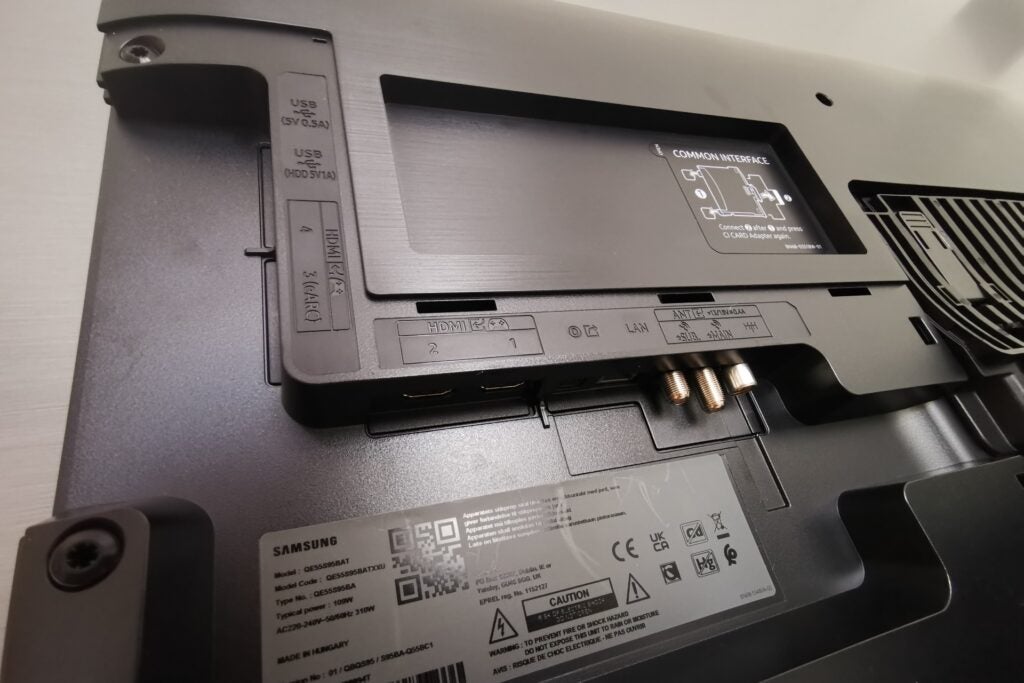
Not that there’s an immediate need to add one. The S95B has a formidable Object Tracking Sound system. Height and side drivers are hidden on the rear, providing soundstage support for the forward-facing array.
To top it all off, the S95B comes with a solar-powered remote control, in addition to a regular IR zapper, which means you’ll save on batteries in the long run.
Features
- Tizen smart platform
- Samsung TV Plus
Smart connectivity is provided by Samsung’s time-tested Tizen platform. There’s been a minor update to simplify navigation, welcome given the amount of content available, but nothing drastic. A sidebar offers tabs for Search, Ambient, Game, Media and Menu.
The Ambient button opens a variety of digital art and relaxing videos, while the Media shortcut takes you to streaming and catch-up services. Samsung doesn’t support Freeview Play, but you’ll still get a full complement of mainstream catch-up apps, and premium SVOD services.
There’s also Samsung TV Plus, Samsung’s own IP delivered channel bouquet, which has a seemingly endless amount of free, linear content to pursue.
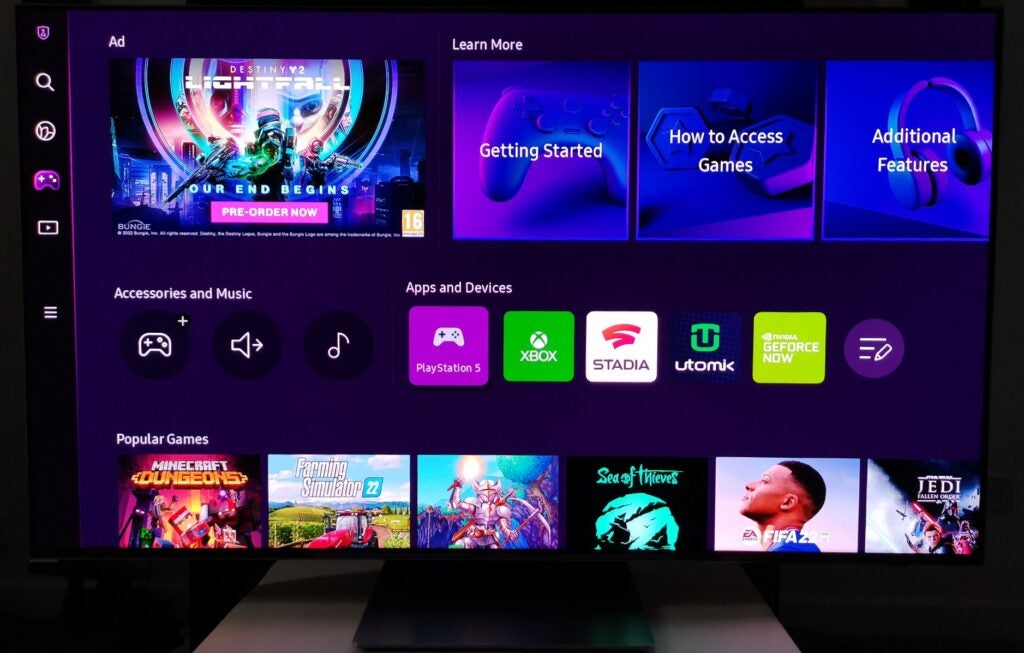
A dedicated Game Hub interface showcases connected consoles and related streaming services. It automatically puts the TV in Game mode. Latency is very good. I measured input lag at just 9.6ms (1080/60) with Game mode selected.
Ultimately, the S95B’s most novel feature is hiding in plain sight: the QD-OLED panel itself. Unlike the WOLED (White OLED) panels popularised by LG Display, Samsung utilises a Quantum Dot layer to derive hues from a single blue OLED source.
The result is a brighter overall picture and improved colour fidelity, without sacrificing black level performance or viewing angle. Let’s take a closer look…
Picture Quality
- Outstanding HDR peak brightness
- Vibrant colour performance
- Expansive sound
Rival OLED makers may have been incrementally increasing performance, but Samsung’s QD-OLED panel design unapologetically outshines the competition. The hype around QD-OLED is real.
The S95B is particularly effective when it comes to bright room viewing. Content remains dynamic and colour rich, even when you’re watching in a room lit by afternoon sun. I’ll caveat that by adding that in a darker room environment, its APL (Average Picture Level) can be a little fatiguing.
The set’s HDR performance is phenomenal. I measured HDR peak brightness at 1415 nits using a 5 per cent window (in Standard picture mode). With a 10 per cent patch, this drops to a still-punchy 962 nits.
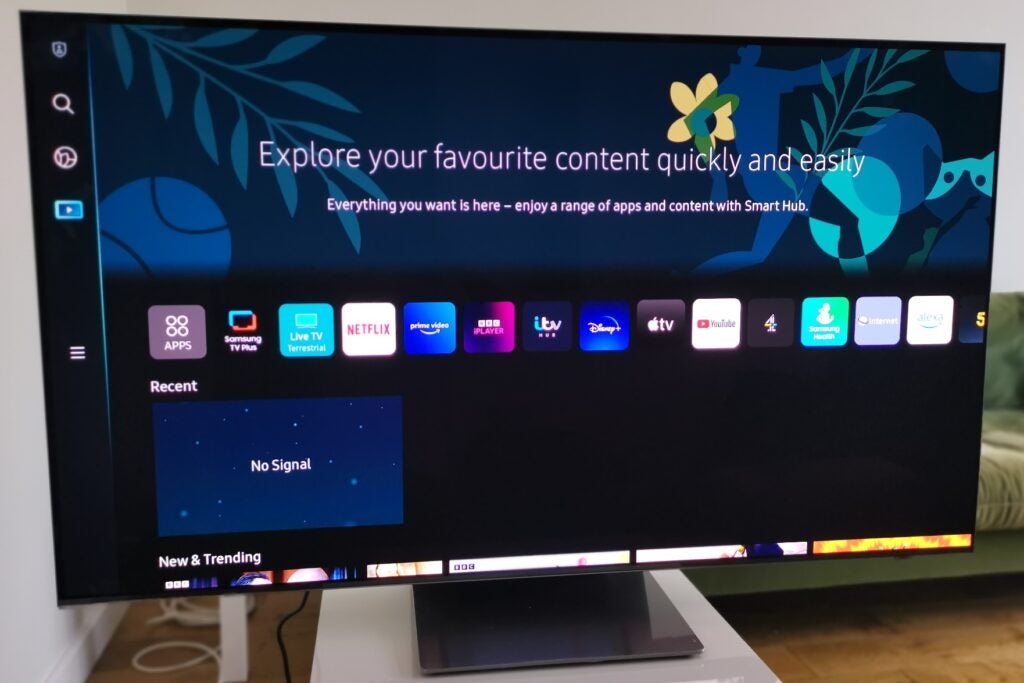
Despite the high picture level, the set still reveals near shadow detail above true black. Gradations are smooth and overall tonality is filmic.
One of the things I like about the S95B is its Intelligent AI optimised AV mode. It removes the need to pick around picture menus, at least for most of the time.
AI Optimization puts both sound and vision on autopilot, analysing content along with your viewing environment, and then adjusting settings accordingly. It’s seamless and efficient.
When Intelligent Mode is disabled, conventional picture presets become available. These comprise Dynamic, Standard, Movie and Filmmaker mode.
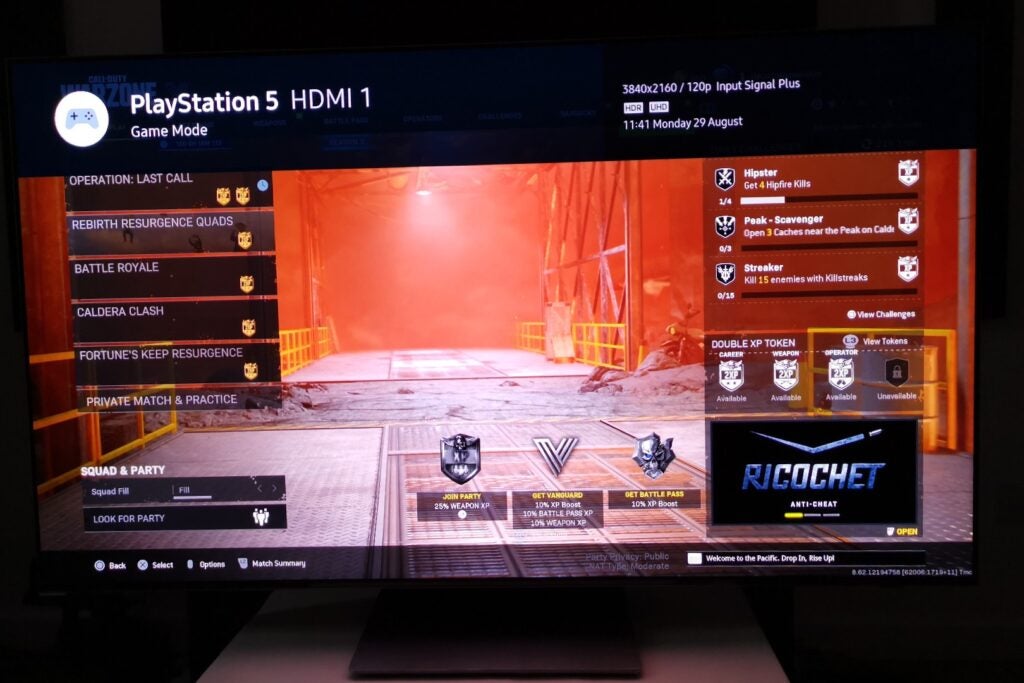
Predictably, the Dynamic setting on this screen is too over saturated; skin tones are less than believable.
Both the Movie and Filmmaker mode tame the more lurid excesses of the panel, good news when you dim the lights for movie night, but I never felt entirely satisfied by either when it came to movie watching. You might feel the need to further explore the settings to ease back on the average picture level, and colour saturation, but then you’re into a world of constant tinkering.
If you don’t want to let AI manage settings, my suggestion is to opt for Standard, which generally offers the best balance of eye candy.
Of course, the TV’s applaudable luminosity doesn’t work for all content. I found the Game mode, triggered automatically by my PS5, a little too cartoony for comfort. Playing Call of Duty: Warzone in low light left my eyeballs stinging. On the plus side, the ubiquity of 4K 120HZ is welcome, and HFR gameplay is gloriously smooth.
Sound Quality
- Dolby Atmos support
- OTS+ tracks sounds across the screen
- Q Symphony compatibility with Samsung soundbars
Sonically, the S95B puts in a strong showing, thanks to those height, width and front array drivers, which have a combined power output of 40W.
The speaker configuration doesn’t offer 360-style immersion, but you do feel as if you’re sitting before a wall of widely spread sound, which is quite a trick given the form factor of this telly.
When you activate Intelligent Mode, you’ll have access to a variety of sonic niceties, including Active Voice Amplifier, Adaptive sound and Adaptive Volume. The Voice Amplifier monitors noise in your viewing room and ensures dialogue is always clear. Adaptive Sound monitors for environmental noise, and then compensates.
If you want to stay within Samsung’s ecosystem, and improve audio performance, there’s a couple of options. The S95B supports Samsung’s Q-Symphony system: when paired with a compatible soundbar, all available drivers sing in harmony. For a full surround sound cinema effect, the S95B can be paired with Wi-Fi surround speakers, although this went untested.
Latest deals
Should you buy it?
You want a high brightness screen for daylight viewing: An LED screen is usually the best option for sets used in moderate or high ambient light, but you’ll typically sacrifice true black depth. Not so with the S95B, it maintains a fantastic dynamic range, as well as outstanding detail and colour depth.
If you want an OLED for a dark room home cinema: The S95B lacks a picture preset that is genuinely cinematic, and when the lights dim it can be a little fatiguing to watch.
Final Thoughts
The S95B is a spectacular OLED debut for Samsung, a brand best known for championing QLED.
Its high brightness and lush colour make it a real crowd pleaser, particularly if it’s likely to be used in a generally bright viewing environment.
HDR punch and dynamic contrast are astonishing.
I also give two thumbs up to the Tizen smart platform. The sheer wealth of functionality available is remarkable. It offers class leading streaming service support and IP delivered channels. If you can’t find anything to watch, then you’re not really trying.
But I have reservations as well. While the S95B has an impressive gaming spec, including four full fat 4K 120HZ capable HDMI inputs, and strong VRR support, its Game mode looks over cranked.
The lack of Dolby Vision is an ongoing irritation for film fans as well.
Ultimately, the audience for this model probably lies somewhere between home cinema enthusiast and hardcore gamer. If that’s you, then get an audition asap.
How we test
We test every television we review thoroughly over an extended period of time. We use industry standard tests to compare features properly. We’ll always tell you what we find. We never, ever, accept money to review a product.
Find out more about how we test in our ethics policy.
Tested for more than a week
Benchmarked with tests
FAQs
We tested on 5% HDR window that the 55-inch S95B could produce 1415 nits of peak brightness.








